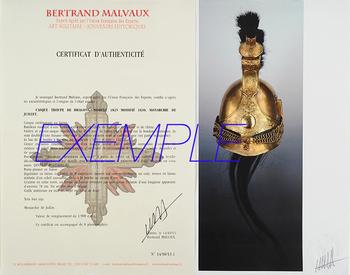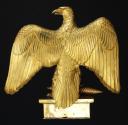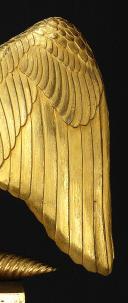
A Napoleonic Eagle of the First Empire (Aigle Premier Empire Modèle 1804)
Sold out
A Napoleonic Eagle of the First Empire (Aigle
Premier Empire Modèle 1804)
A finely-made Eagle of 1804 Pattern, of cast bronze, chased and gilded, the head horizontal, with elongated half-open beak with tongue clearly visible in the lower part, the wings spread wide at the tips. The bird formed in two pieces : the front and back (including the left talon) fitted and soldered together, with separately-formed right talon. A thunderbolt attached at a slight angle, without lightning-flashes. Eagle and Thunderbolt mounted on a plinth of rectangular shape, the front and back each with four mounting-holes for Regimental number (numerals now missing, but probably originally 23, 27 or 29, although this is not certain). The underside of the plinth fitted with a plate and incorporating a cylindrical metal socket to receive a wooden staff (the socket now cut off flush with the base of the plinth). The Eagle stamped DLVI underneath the left talon, and with letter A under the right talon ; the underside of the Thunderbolt stamped DLVI followed by the letter A, the top of the plinth and the upper side of its baseplate both similarly stamped ; the shortened socket stamped A (the remainder of the DLVI mark not visible).
Weight
Overall weight : 1.8 kg
Eagle : 1.3 kg
Thunderbolt : 0.1 kg
Plinth (complete with baseplate and part socket) 0.4 kg
Dimensions
- Eagle :
Height of front 203 mm
Height of rear from tip of tail feathers to top of head : approximately 220 mm
Width 250 mm
- Thunderbolt :
Length : 140 mm
Max diameter 42 mm, min diameter approximately 24 mm at its center
- Plinth :
Height 43 mm
Maximum lenght115 mm, minimum length 100 mm
Maximum width 61 mm, minimum width 43/44 mm
Baseplate length 102 mm, width 45 mm, thickness approximately 2 mm
- Socket :
Length now 42 mm (would originally have been approximately 90-100 mm)
Diameter 31 mm
Condition
Good general condition. Some minor defects, dating from time of manufacture, to soldered join between the front and rear sections (such defects are however always found on authentic Eagles) ; some gilt remaining to Eagle and Thunderbolt, and traces of gilt on plinth (mainly on upper part) ; pole-socket now shortened as described above.
History
On the 18th May 1804, General Bonaparte was proclaimed Emperor of the French. Senate, and the Council of State was made responsible for devising an emblem for the new regime. Napoleon chose the Eagle with outstretched wings, and the well-known painter Isabey was charged with designing it. The project was executed by Thomire after original work by Chaudet.
On the 27th July 1804, at his headquarters at Pont-de-Briques, the Emperor resolved that this Eagle, in gilt-bronze, should henceforth be placed at the top of the staves of new colours and standards. Thereafter, the Eagle became the essential element of a standard, rather than the «silk», which under the Monarchy and Revolution had been the key component of any regimental flag, whereas the staff and finial had then had no importance by comparison. It was the Emperor himself who gave the name of «Eagles» to his standards. The Eagles were presented by Napoleon in person, the most famous of the presentations being that of 14 frimaire An 13 (5th December 1804) at the Champ-de-Mars ; another particularly dramatic distribution took place during the «Hundred Days», on 1st June 1815. During his reign, the Emperor also presented other Eagles at military reviews at the Tuileries.
Features of Eagles of the 1804, 1810-11 and 1815 Patterns
Three patterns of Eagles were produced during the First Empire : the 1804 model, as described above (head turned to the right, wings somewhat spread, left claw holding a thunderbolt without lighting-flashes), in fire-gilt bronze, at a cost of 145 Francs ; in 1810-11 another pattern, known as the Light Model, was introduced. Manufactured from 1809 onwards, this was a less well-made item, whose weight was reduced from the 1.85 kg - 2.0 kg of the 1804 model to approximately 800 gm, produced at a cost of 165 Francs.
At the Restoration of 1814, the Eagles were withdrawn from service, and consequently, when Napoleon returned to France early in 1815, another issue of Eagles was required. The new Eagle, again the work of Thomire, was heavier, at 1.45 kg, than the Light Model, and cheaper, costing only 95 Francs, a figure which reflected its lower quality of manufacture. The beak of this Eagle was more curved than that of its predecessors, and the wings more drooping, with the tips closer to the body. The height was 18 to 20 cm.Distribution of Eagles during the Empire and surviving examples
By the Decree of 10th July 1804, every infantry battalion and cavalry squadron was to receive an Eagle, requiring a total issue of more than 1 100. Production of this quantity, and the presentations of the Eagles, was not completed until the following year.On the 18th February 1808, the allocation of Eagles was reduced to one per regiment, and a large number were returned to War Administration, some being re-issued as replacements for those lost in action. Between 1807 and 1814, some 100 new Eagles were presented to new regiments, or to regiments which had « honourably lost » their Eagles in battle. At the Champ de Mai, on the 1st and 4th June 1815, a total of 292 Eagles were presented.
Today, some 124 authentic examples of the 1804 pattern Eagle are known to exist (46 in French museums, 10 in British museums, 55 in museums elsewhere, and about 13 in private collections). Some 17 «Light Model» Eagles of 1810-11 are known, (7 in French museums, 2 in British museums, 7 in other museums and on or two in private hands) ; of the 1815 issue Eagles, only about 14 still exist (3 in French museums, 2 in British museums, 2 or 3 in museums elsewhere, and about 7 in private ownership). These figures do not include Eagles issued to Garde Nationale units or «special patterns» of Eagles.
Premier Empire Modèle 1804)
A finely-made Eagle of 1804 Pattern, of cast bronze, chased and gilded, the head horizontal, with elongated half-open beak with tongue clearly visible in the lower part, the wings spread wide at the tips. The bird formed in two pieces : the front and back (including the left talon) fitted and soldered together, with separately-formed right talon. A thunderbolt attached at a slight angle, without lightning-flashes. Eagle and Thunderbolt mounted on a plinth of rectangular shape, the front and back each with four mounting-holes for Regimental number (numerals now missing, but probably originally 23, 27 or 29, although this is not certain). The underside of the plinth fitted with a plate and incorporating a cylindrical metal socket to receive a wooden staff (the socket now cut off flush with the base of the plinth). The Eagle stamped DLVI underneath the left talon, and with letter A under the right talon ; the underside of the Thunderbolt stamped DLVI followed by the letter A, the top of the plinth and the upper side of its baseplate both similarly stamped ; the shortened socket stamped A (the remainder of the DLVI mark not visible).
Weight
Overall weight : 1.8 kg
Eagle : 1.3 kg
Thunderbolt : 0.1 kg
Plinth (complete with baseplate and part socket) 0.4 kg
Dimensions
- Eagle :
Height of front 203 mm
Height of rear from tip of tail feathers to top of head : approximately 220 mm
Width 250 mm
- Thunderbolt :
Length : 140 mm
Max diameter 42 mm, min diameter approximately 24 mm at its center
- Plinth :
Height 43 mm
Maximum lenght115 mm, minimum length 100 mm
Maximum width 61 mm, minimum width 43/44 mm
Baseplate length 102 mm, width 45 mm, thickness approximately 2 mm
- Socket :
Length now 42 mm (would originally have been approximately 90-100 mm)
Diameter 31 mm
Condition
Good general condition. Some minor defects, dating from time of manufacture, to soldered join between the front and rear sections (such defects are however always found on authentic Eagles) ; some gilt remaining to Eagle and Thunderbolt, and traces of gilt on plinth (mainly on upper part) ; pole-socket now shortened as described above.
History
On the 18th May 1804, General Bonaparte was proclaimed Emperor of the French. Senate, and the Council of State was made responsible for devising an emblem for the new regime. Napoleon chose the Eagle with outstretched wings, and the well-known painter Isabey was charged with designing it. The project was executed by Thomire after original work by Chaudet.
On the 27th July 1804, at his headquarters at Pont-de-Briques, the Emperor resolved that this Eagle, in gilt-bronze, should henceforth be placed at the top of the staves of new colours and standards. Thereafter, the Eagle became the essential element of a standard, rather than the «silk», which under the Monarchy and Revolution had been the key component of any regimental flag, whereas the staff and finial had then had no importance by comparison. It was the Emperor himself who gave the name of «Eagles» to his standards. The Eagles were presented by Napoleon in person, the most famous of the presentations being that of 14 frimaire An 13 (5th December 1804) at the Champ-de-Mars ; another particularly dramatic distribution took place during the «Hundred Days», on 1st June 1815. During his reign, the Emperor also presented other Eagles at military reviews at the Tuileries.
Features of Eagles of the 1804, 1810-11 and 1815 Patterns
Three patterns of Eagles were produced during the First Empire : the 1804 model, as described above (head turned to the right, wings somewhat spread, left claw holding a thunderbolt without lighting-flashes), in fire-gilt bronze, at a cost of 145 Francs ; in 1810-11 another pattern, known as the Light Model, was introduced. Manufactured from 1809 onwards, this was a less well-made item, whose weight was reduced from the 1.85 kg - 2.0 kg of the 1804 model to approximately 800 gm, produced at a cost of 165 Francs.
At the Restoration of 1814, the Eagles were withdrawn from service, and consequently, when Napoleon returned to France early in 1815, another issue of Eagles was required. The new Eagle, again the work of Thomire, was heavier, at 1.45 kg, than the Light Model, and cheaper, costing only 95 Francs, a figure which reflected its lower quality of manufacture. The beak of this Eagle was more curved than that of its predecessors, and the wings more drooping, with the tips closer to the body. The height was 18 to 20 cm.Distribution of Eagles during the Empire and surviving examples
By the Decree of 10th July 1804, every infantry battalion and cavalry squadron was to receive an Eagle, requiring a total issue of more than 1 100. Production of this quantity, and the presentations of the Eagles, was not completed until the following year.On the 18th February 1808, the allocation of Eagles was reduced to one per regiment, and a large number were returned to War Administration, some being re-issued as replacements for those lost in action. Between 1807 and 1814, some 100 new Eagles were presented to new regiments, or to regiments which had « honourably lost » their Eagles in battle. At the Champ de Mai, on the 1st and 4th June 1815, a total of 292 Eagles were presented.
Today, some 124 authentic examples of the 1804 pattern Eagle are known to exist (46 in French museums, 10 in British museums, 55 in museums elsewhere, and about 13 in private collections). Some 17 «Light Model» Eagles of 1810-11 are known, (7 in French museums, 2 in British museums, 7 in other museums and on or two in private hands) ; of the 1815 issue Eagles, only about 14 still exist (3 in French museums, 2 in British museums, 2 or 3 in museums elsewhere, and about 7 in private ownership). These figures do not include Eagles issued to Garde Nationale units or «special patterns» of Eagles.
Reference :
207

Next update Friday, april 4th at 1:30 PM
FOR ALL PURCHASES, PAYMENT IN MULTIPLE CHECKS POSSIBLE
bertrand.malvaux@wanadoo.fr 06 07 75 74 63
An authenticity certificate of the item including the description published on the site, the period, the sale price, accompanied by one or more color photographs is automatically provided for any item priced over 130 euros. Below this price, each certificate is charged 5 euros.
Only items sold by me are subject to an authenticity certificate, I do not provide any expert reports for items sold by third parties (colleagues or collectors).







